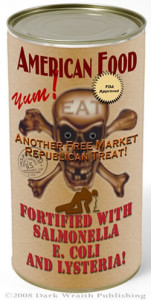In an earlier post, I asked whether foodborne illnesses were on the rise. (Not just peanut butter: What’s happening to our food supply?) A recent story in The New York Times addresses that same question.
Heather Whybrew, a college student in Washington State, became gravely ill after eating a salad in her school cafeteria. Carl Ours, of Ohio, was temporarily paralyzed after eating chili dogs and drinking beer. Mari Tardiff, of California, spent three months on life support after she drank unpasteurized milk. … Is it becoming more dangerous to eat?
 In 1996, the CDC improved its method of collecting information on foodborne illnesses. The Foodborne Diseases Active Surveillance Network (FoodNet) began monitoring seven foodborne diseases in clinical laboratories throughout the U.S. Although this change makes it difficult to compare historical information before and after 1996, public health officials believe food is definitely safer now than it was a century ago, before refrigeration, pasteurization, and municipal sewer systems.
In 1996, the CDC improved its method of collecting information on foodborne illnesses. The Foodborne Diseases Active Surveillance Network (FoodNet) began monitoring seven foodborne diseases in clinical laboratories throughout the U.S. Although this change makes it difficult to compare historical information before and after 1996, public health officials believe food is definitely safer now than it was a century ago, before refrigeration, pasteurization, and municipal sewer systems.
It’s probably safer now than it was 10 years ago, although there’s still plenty to worry about. According to Caroline Smith DeWaal, director of food safety at the Center for Science in the Public Interest, “The trends clearly show that consumers should be more worried about the food supply because the hazards are becoming more pronounced.”
Whenever there appears to be an increase in an illness, one of the first questions is whether there’s really an increase or if it’s simply that more cases are being reported. This is as much an issue for foodborne illnesses as it is, say, for the apparent increase in attention deficit disorder diagnoses. If food is now safer, why are there more contamination scares and more recalls?
Part of the answer is that we now have more sophisticated genetic techniques for identifying the sources of outbreaks. Once salmonella was identified in a jar of peanut butter in Minnesota, it was possible to identify that same strain in 46 other states where people were reporting illness. Those same genetic techniques allowed the CDC to trace the source to a small plant in Georgia. Once the source was identified, it was possible to trace the tendrils of the contamination to its many locations. So far 3,913 different types of products have been recalled in connection with the latest peanut butter scare.
The Times article concludes with a cautionary note about trying to avoid the dangers of the modern industrial food system by consuming more natural, alternative products.
Concerned about health, Ms. Tardiff, the California nurse, bought organic and less processed foods whenever possible. She decided to try raw milk, believing the unpasteurized product would supply helpful organisms.
Instead, she got a dose of an unhelpful germ: campylobacter, easily killed by pasteurization. The ensuing intestinal illness caused a debilitating nerve disease. Ms. Tardiff communicated by blinking for months, and still cannot stand or use her hands.“This has been life-altering,” she said. “All I want to say is, ‘Be careful.’ ”
Related posts:
Links of interest: Organic food
What’s wrong with our food?
Pig dignity: Animal welfare in Europe
Is agriculture bad for your health?
Not just peanut butter: What’s happening to our food supply?
Sources:
Andrew Martin and Gardiner Harris, Outbreaks Put Worry on the Table, New York Times, May 10, 2009


Sorry, comments are closed for this post.